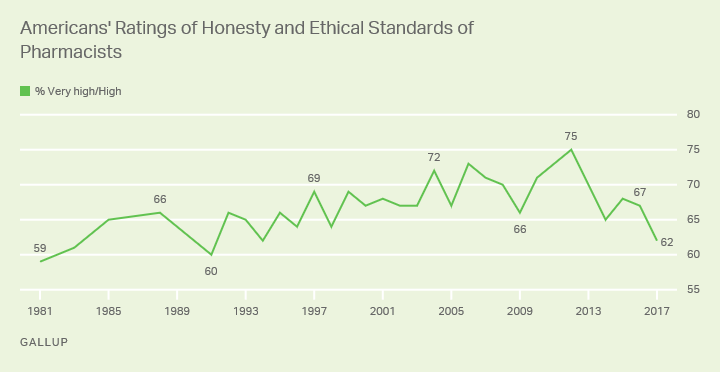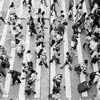Story Highlights
- Nurses outpace 21 other professions on honesty and ethics rating
- Clergy have declined to lowest historical positive rating of 42%
- Largest partisan gaps on police officers, newspaper reporters
WASHINGTON, D.C. -- For the 16th consecutive year, Americans' ratings of the honesty and ethical standards of 22 occupations finds nurses at the top of the list. More than eight in 10 (82%) Americans describe nurses' ethics as "very high" or "high." In contrast, about six in 10 Americans rate members of Congress (60%) and lobbyists (58%) as "very low" or "low" when it comes to honesty and ethical standards.
| Very high/High | Average | Very low/Low | |||||||||||||||||||||||||||||||||||||||||||||||||||||||||||||||||||||||||||||||||||||||||||||||||
|---|---|---|---|---|---|---|---|---|---|---|---|---|---|---|---|---|---|---|---|---|---|---|---|---|---|---|---|---|---|---|---|---|---|---|---|---|---|---|---|---|---|---|---|---|---|---|---|---|---|---|---|---|---|---|---|---|---|---|---|---|---|---|---|---|---|---|---|---|---|---|---|---|---|---|---|---|---|---|---|---|---|---|---|---|---|---|---|---|---|---|---|---|---|---|---|---|---|---|---|
| % | % | % | |||||||||||||||||||||||||||||||||||||||||||||||||||||||||||||||||||||||||||||||||||||||||||||||||
| Nurses | 82 | 16 | 2 | ||||||||||||||||||||||||||||||||||||||||||||||||||||||||||||||||||||||||||||||||||||||||||||||||
| Military officers | 71 | 24 | 3 | ||||||||||||||||||||||||||||||||||||||||||||||||||||||||||||||||||||||||||||||||||||||||||||||||
| Grade school teachers | 66 | 27 | 5 | ||||||||||||||||||||||||||||||||||||||||||||||||||||||||||||||||||||||||||||||||||||||||||||||||
| Medical doctors | 65 | 31 | 4 | ||||||||||||||||||||||||||||||||||||||||||||||||||||||||||||||||||||||||||||||||||||||||||||||||
| Pharmacists | 62 | 32 | 6 | ||||||||||||||||||||||||||||||||||||||||||||||||||||||||||||||||||||||||||||||||||||||||||||||||
| Police officers | 56 | 32 | 12 | ||||||||||||||||||||||||||||||||||||||||||||||||||||||||||||||||||||||||||||||||||||||||||||||||
| Day care providers | 46 | 43 | 7 | ||||||||||||||||||||||||||||||||||||||||||||||||||||||||||||||||||||||||||||||||||||||||||||||||
| Judges | 43 | 41 | 15 | ||||||||||||||||||||||||||||||||||||||||||||||||||||||||||||||||||||||||||||||||||||||||||||||||
| Clergy | 42 | 41 | 13 | ||||||||||||||||||||||||||||||||||||||||||||||||||||||||||||||||||||||||||||||||||||||||||||||||
| Auto mechanics | 32 | 53 | 14 | ||||||||||||||||||||||||||||||||||||||||||||||||||||||||||||||||||||||||||||||||||||||||||||||||
| Nursing home operators | 26 | 48 | 22 | ||||||||||||||||||||||||||||||||||||||||||||||||||||||||||||||||||||||||||||||||||||||||||||||||
| Bankers | 25 | 54 | 21 | ||||||||||||||||||||||||||||||||||||||||||||||||||||||||||||||||||||||||||||||||||||||||||||||||
| Newspaper reporters | 25 | 39 | 35 | ||||||||||||||||||||||||||||||||||||||||||||||||||||||||||||||||||||||||||||||||||||||||||||||||
| Local officeholders | 24 | 53 | 20 | ||||||||||||||||||||||||||||||||||||||||||||||||||||||||||||||||||||||||||||||||||||||||||||||||
| TV reporters | 23 | 39 | 37 | ||||||||||||||||||||||||||||||||||||||||||||||||||||||||||||||||||||||||||||||||||||||||||||||||
| State officeholders | 19 | 47 | 33 | ||||||||||||||||||||||||||||||||||||||||||||||||||||||||||||||||||||||||||||||||||||||||||||||||
| Lawyers | 18 | 53 | 28 | ||||||||||||||||||||||||||||||||||||||||||||||||||||||||||||||||||||||||||||||||||||||||||||||||
| Business executives | 16 | 54 | 28 | ||||||||||||||||||||||||||||||||||||||||||||||||||||||||||||||||||||||||||||||||||||||||||||||||
| Advertising practitioners | 12 | 49 | 34 | ||||||||||||||||||||||||||||||||||||||||||||||||||||||||||||||||||||||||||||||||||||||||||||||||
| Members of Congress | 11 | 29 | 60 | ||||||||||||||||||||||||||||||||||||||||||||||||||||||||||||||||||||||||||||||||||||||||||||||||
| Car salespeople | 10 | 48 | 39 | ||||||||||||||||||||||||||||||||||||||||||||||||||||||||||||||||||||||||||||||||||||||||||||||||
| Lobbyists | 8 | 31 | 58 | ||||||||||||||||||||||||||||||||||||||||||||||||||||||||||||||||||||||||||||||||||||||||||||||||
| GALLUP, Dec. 4-11, 2017 | |||||||||||||||||||||||||||||||||||||||||||||||||||||||||||||||||||||||||||||||||||||||||||||||||||
Nurses have surpassed all other professions every year but one since Gallup first asked about them in 1999. In 2001, Gallup included firefighters on the list after the 9/11 terrorist attacks, and 90% of the public rated their honesty and ethical standards as "high" or "very high."
Overall, a majority of Americans in the Dec. 4-11 poll rated six professions as "high" or "very high" for honesty and ethical standards. In addition to nurses, that list includes military officers, grade school teachers, medical doctors, police officers and pharmacists. The honesty rating of pharmacists, although still high on an absolute basis, dropped five points since last year and is at its lowest point since 1994, possibly reflecting the current nationwide opioid crisis.

While only members of Congress and lobbyists received majority negative ratings, the remaining 14 occupations were rated "average" for their honesty and ethical standards by pluralities or majorities ranging from 39% to 54%. Those garnering majority "average" marks for honesty and ethical standards are lawyers, local officeholders, bankers and auto mechanics. The public is divided between positive and average honesty rankings for both judges and members of the clergy -- two occupations that are looked to as requiring the utmost honesty and ethical standards.
Clergy Ethical Rating Still Declining
Gallup has measured Americans' views on the honesty and ethics of the clergy 33 times dating back to 1977. Although the overall average positive rating is 55%, it has fallen below that level since 2009. This year marks the lowest rating to date, with 42% saying the clergy has "very high" or "high" honesty and ethical standards. The historical high of 67% occurred in 1985.

Views of the honesty and ethics of the clergy dropped precipitously in 2002 amid the sexual abuse scandal in the Catholic Church. While positive ratings of the clergy's honesty and integrity rebounded somewhat in the next few years, they fell to 50% in 2009 and have been steadily declining since then.
Party Differences in Views of Professions
In this age of extreme political polarization, it is perhaps not surprising that partisans have sharply different opinions of some of the professions Gallup tested. Yet, the professions with the largest gaps between Republican and Democratic opinions have shown similar partisan differences in the past.
| Republican | Independent | Democrat | Republican/Democratic difference | ||||||||||||||||||||||||||||||||||||||||||||||||||||||||||||||||||||||||||||||||||||||||||||||||
|---|---|---|---|---|---|---|---|---|---|---|---|---|---|---|---|---|---|---|---|---|---|---|---|---|---|---|---|---|---|---|---|---|---|---|---|---|---|---|---|---|---|---|---|---|---|---|---|---|---|---|---|---|---|---|---|---|---|---|---|---|---|---|---|---|---|---|---|---|---|---|---|---|---|---|---|---|---|---|---|---|---|---|---|---|---|---|---|---|---|---|---|---|---|---|---|---|---|---|---|
| % | % | % | % | ||||||||||||||||||||||||||||||||||||||||||||||||||||||||||||||||||||||||||||||||||||||||||||||||
| Police officers | 80 | 47 | 48 | +32 | |||||||||||||||||||||||||||||||||||||||||||||||||||||||||||||||||||||||||||||||||||||||||||||||
| Military officers | 86 | 69 | 60 | +26 | |||||||||||||||||||||||||||||||||||||||||||||||||||||||||||||||||||||||||||||||||||||||||||||||
| Clergy | 59 | 35 | 41 | +18 | |||||||||||||||||||||||||||||||||||||||||||||||||||||||||||||||||||||||||||||||||||||||||||||||
| Pharmacists | 70 | 60 | 58 | +12 | |||||||||||||||||||||||||||||||||||||||||||||||||||||||||||||||||||||||||||||||||||||||||||||||
| Judges | 54 | 38 | 42 | +12 | |||||||||||||||||||||||||||||||||||||||||||||||||||||||||||||||||||||||||||||||||||||||||||||||
| TV reporters | 12 | 19 | 40 | -28 | |||||||||||||||||||||||||||||||||||||||||||||||||||||||||||||||||||||||||||||||||||||||||||||||
| Newspaper reporters | 12 | 19 | 46 | -34 | |||||||||||||||||||||||||||||||||||||||||||||||||||||||||||||||||||||||||||||||||||||||||||||||
| GALLUP, Dec. 4-11, 2017 | |||||||||||||||||||||||||||||||||||||||||||||||||||||||||||||||||||||||||||||||||||||||||||||||||||
Republicans are much more likely than Democrats to rate police officers, military officers, clergy, pharmacists and judges "very high" or "high" on honesty and ethics, which hasn't changed much in recent years. Republicans are more conservative and more religious than Democrats which likely contributes to their ethics ratings.
For their part, Democrats consider television and newspaper reporters much more honest than do Republicans, although Democrats' honesty ratings for these professions fall below the 50% mark. This partisan divide reinforces recent Gallup findings that Democrats' trust in the media is much higher than that of Republicans'.
While Gallup did not measure attitudes about newspaper and television reporters last year, the very high/high reading for "journalists" showed a 15-point gap between Republicans and Democrats last year. Looking at "reporters" this year, that gap is roughly double what it was for "journalists" last year.
Yet, in a rare show of unity, roughly six in 10 Republicans, independents and Democrats alike rate the honesty of members of Congress lower than all other professions tested. Likewise, lobbyists are universally viewed as having very low or low ethics by roughly the same percentages as members of Congress.
Bottom Line
Three of the professions rated highest for honesty and ethical standards are in the healthcare field - nurses, medical doctors and pharmacists - a trend that has been the case in recent years. Yet, pharmacists, who were at the top of the list of honest professions for years, have taken a slight downturn in the last year as the U.S. opioid epidemic has become increasingly problematic, leading President Donald Trump to declare it a public health emergency. While the clergy are not at the bottom of the list of professions, this year's ratings represent a new low for a profession with image problems in recent years.
Survey Methods
Results for this Gallup poll are based on telephone interviews conducted Dec. 4-11, 2017, with a random sample of 1,049 adults, aged 18 and older, living in all 50 U.S. states and the District of Columbia. For results based on the total sample of national adults, the margin of sampling error is ±4 percentage points at the 95% confidence level. All reported margins of sampling error include computed design effects for weighting.
Each sample of national adults includes a minimum quota of 70% cellphone respondents and 30% landline respondents, with additional minimum quotas by time zone within region. Landline and cellular telephone numbers are selected using random-digit-dial methods.
View survey methodology, complete question responses and trends.




